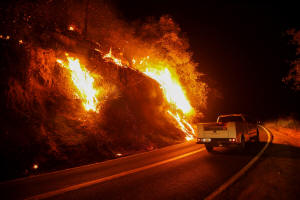What's causing the recent U.S. heat waves?
 Send a link to a friend
Send a link to a friend
 [August 18, 2022]
By Daniel Trotta [August 18, 2022]
By Daniel Trotta
(Reuters) - Much of the western United
States will be gripped by a heat wave this week, with temperatures in
some parts of California soaring above 110 Fahrenheit (43 Celsius) on
Wednesday.
The extreme heat is also raising the risk of wildfires. The Wishon Fire,
a 350-acre blaze in the Sequoia National Forest in California, was 35%
contained. (Graphic: https://tmsnrt.rs/3T9z9BB)
Here are some factors causing the heat waves, according to scientists.
HUMAN-INFLUENCED CLIMATE CHANGE
Climate change caused by the burning of fossil fuels is a global
phenomenon that is certainly playing a role in what the United States is
experiencing, scientists say.
"Climate change is making extreme and unprecedented heat events both
more intense and more common, pretty much universally throughout the
world," said Daniel Swain, climate scientist at the University of
California at Los Angeles.
"Heat waves are probably the most underestimated type of potential
disaster because they routinely kill a lot of people. And we just don't
hear about it because it doesn't kill them in, to put it bluntly,
sufficiently dramatic ways. There aren't bodies on the street," said
Swain.
Jennifer Francis, senior scientist at the Woodwell Climate Research
Center, said with climate change the world is seeing shifting wind
patterns and weather systems in ways that makes heat waves more intense,
persistent and widespread.

Alex Ruane, researcher at NASA's Goddard Institute for Space Studies,
said as the world warms, it takes less of a natural anomaly to cause
extreme heat categories.
"Because we're closer to those thresholds, it's more likely that you'll
get more than one heat wave at the same time. We're seeing this in the
United States."
ARCTIC WARMING AND JET STREAM MIGRATION
The Arctic is warming three to four times faster than the globe as a
whole, meaning there is ever less difference between northern
temperatures and those closer to the equator.
[to top of second column]
|

A vehicle passes by the flames from
Wishon Fire as it burns near Springville, California, U.S., August
15, 2022. REUTERS/David Swanson

That is resulting in swings in the North Atlantic jet stream, which
in turn leads to extreme weather events like heat waves and floods,
according to Francis at the Woodwell Climate Research Center.
HEAT DOMES
Warmer oceans contribute to heat domes, which trap heat over large
geographical areas.
Scientists say the main cause of heat domes is a strong change in
ocean temperatures from west to east, which occurs in the tropical
Pacific Ocean the preceding winter.
"As prevailing winds move the hot air east, the northern shifts of
the jet stream trap the air and move it toward land, where it sinks,
resulting in heat waves," the U.S. National Oceanic and Atmospheric
Administration says on its website.
EL NINO AND LA NINA
Every few years, the climate patterns known as El Nino and, less
frequently, La Nina occur. El Nino brings warm water from the
equatorial Pacific Ocean up to the western coast of North America,
and La Nina brings colder water.
At present, La Nina is in effect. Because summer temperatures trend
lower during La Nina, climate scientists are concerned about what a
serious heat wave would look like during the next El Nino, when even
hotter summer weather could be expected.
(Reporting by Daniel Trotta; Editing by Donna Bryson, Lisa Shumaker
and Josie Kao)
[© 2022 Thomson Reuters. All rights
reserved.]
This material may not be published,
broadcast, rewritten or redistributed.
Thompson Reuters is solely responsible for this content.
 |